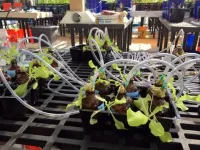(Press-News.org) SILVER SPRING, Md.--A systematic review of multiple randomized controlled studies among adults with overweight or obesity showed that greater engagement in self-monitoring using digital health tools was associated with significant weight loss, according to a paper published online in Obesity, The Obesity Society's flagship journal. This is the first comprehensive systematic review to examine the relationship between digital self-monitoring and weight loss.
"Digital health tools have flourished in the past decade," said Michele L. Patel, PhD, post-doctoral research fellow, Stanford Prevention Research Center, Stanford University School of Medicine in Stanford, Calif. "What this paper sought out to explore was whether tracking via these digital tools is effective at producing greater weight loss." Patel is the corresponding author of the study.
Given the wide-spread prevalence of obesity with rates of 42 percent among US adults and 13 percent worldwide, treatment options that have high efficacy, acceptability and reach are needed. As found in previous reviews, interventions using technology-based modalities, including SMS, apps, wearables and websites often produced weight loss similar to or less than that of in-person interventions but better than that of control arms; however these reviews did not focus on self-monitoring. The current research addresses this gap and contributes to the science of engagement in behavioral interventions.
Conducted in accordance with the Preferred Reporting Items for Systematic Reviews and Meta-Analyses guidelines, the review included 39 randomized controlled studies of behavioral weight loss interventions for adults with overweight or obesity using digital health technologies for self-monitoring. Six databases--PubMed, EMBASE, Scopus, PsycInfo, CINAHL and ProQuest Dissertations & Theses--were searched for studies that included interventions 12 weeks or longer in duration, weight outcomes six months or longer and outcomes on self-monitoring engagement and their relationship to weight loss. The studies were published between January 2009 and September 2019.
Among the 67 interventions with digital self-monitoring, weight was tracked in 72 percent of them, diet in 81 percent and physical activity in 82 percent. Websites were the most common self-monitoring technology tools followed by apps, wearables, electronic scales and text messaging. No studies used social media platforms for self-monitoring.
Digital self-monitoring was linked to weight loss in 74 percent of occurrences. This pattern was found across all three major behaviors that are tracked (dietary intake, physical activity and body weight). Few interventions had digital self-monitoring engagement rates greater than 75 percent of days. Rates were higher in digital tools than in paper-based journals in 21 out of 34 comparisons. "This may be because many digital tools are highly portable, and therefore allow the user to track any time of the day; digital tools also may make tracking quicker, and may be less burdensome to use," said Patel.
"Given that previous reviews conducted before the emergence of these newer tools have established that self-monitoring also plays a key role in the maintenance of weight loss (i.e., preventing weight regain), a critical next step for our field is to examine how we can help sustain engagement with these tools longer term, after the initial novelty wears off," said Assistant Professor Kathryn M. Ross, PhD, MPH, Department of Clinical and Health Psychology, University of Florida, Gainesville. Ross was not associated with the research.
INFORMATION:
Other authors of the study include Lindsay Wakayama of Integrated Care Psychology, San Francisco VA Health Care System, San Francisco, Calif., and Gary Bennett of the Department of Psychology and Neuroscience, Duke University and Duke Digital Health Science Center, Duke Global Health Institute, Durham, NC.
The paper, titled "Self-Monitoring via Digital Health in Weight Loss Interventions: A Systematic Review Among Adults with Overweight or Obesity," will be published in the March 2021 print issue.
The Obesity Society (TOS) is the leading organization of scientists and health professionals devoted to understanding and reversing the epidemic of obesity and its adverse health, economic and societal effects. Combining the perspective of researchers, clinicians, policymakers and patients, TOS promotes innovative research, education and evidence-based clinical care to improve the health and well-being of all people with obesity. For more information, visit http://www.obesity.org.
Do you dim the lighting and turn on the red light for a romantic night in with your partner? It turns out moths aren't so different in that regard. A new study published in END ...
Mangrove forests with greater species diversity can store more carbon, according to new research published in the British Ecological Society journal Functional Ecology.
Researchers studying mangrove forests in Hainan Island, China, have found that species diversity in mangrove forests enhances both biomass production (the quantity of organic matter) and soil carbon storage. The findings highlight the impotence of conserving mangrove biodiversity as a nature-based solution to mitigate climate change.
The East side of the island was found to have the highest mangrove biomass, diversity and carbon storage, with a mean of 537 tonnes of carbon per hectare (Mg C ha-1). ...
CLEVELAND, Ohio (Feb 24, 2021)--The aging population combined with increasing obesity rates has resulted in more women experiencing pelvic organ prolapse. Common treatment options include pelvic reconstructive surgery or the use of pessaries to prop up descending organs. A new study evaluated the long-term effectiveness of pessaries, as well as reasons why women discontinued their use. Study results are published online today in Menopause, the journal of The North American Menopause Society (NAMS).
Despite the fact that vaginal pessaries have existed in some form for thousands of years to help treat pelvic organ prolapse, few studies have been published regarding their long-term use and effectiveness. Pessaries are devices inserted into the vagina ...
Organic molecules that capture photons and convert these into electricity have important applications for producing green energy. Light-harvesting complexes need two semiconductors, an electron donor and an acceptor. How well they work is measured by their quantum efficiency, the rate by which photons are converted into electron-hole pairs.
Quantum efficiency is lower than optimal if there is "self-quenching", where one molecule excited by an incoming photon donates some of its energy to an identical non-excited molecule, yielding two molecules at an intermediate energy state too low ...
BINGHAMTON, NY -- Ancestry estimation -- a method used by forensic anthropologists to determine ancestral origin by analyzing bone structures -- is rooted in "race science" and perpetuates white supremacy, according to a new paper by a forensic anthropologist at Binghamton University, State University of New York.
By themselves, bones seem somewhat uniform to the untrained eye. They lack the traits we so often use to categorize fellow humans: hair texture, the shape of nose and eye, skin pigmentation.
Forensic anthropologists know that race isn't based in biological fact, but in a history and culture that assigns meaning to physical traits that occur among different ...
Carbon nanotubes are tiny. They can be a hundred thousand times smaller than the width of a human hair. But they have huge potential.
Products manufactured using carbon nanotubes include rebar for concrete, sporting goods, wind turbines, and lithium batteries, among others.
Potential uses of carbon nanotubes could extend to diverse fields, such as agriculture, biomedicine and space science.
But as we use more carbon nanotubes to make things, we also increase the chances that these nanotubes enter different environments and ecosystems.
"That makes it important to understand how ...
February 24, 2021 - The second study published in as many months has identified another reason to add more mushrooms to the recommended American diet. The new research , published in Food & Nutrition Research (February 2021), examined the addition of mushrooms to U.S. Department of Agriculture (USDA) Food Patterns resulting in the increase of several micronutrients including shortfall nutrients, while having a minimal to zero impact on overall calories, sodium or saturated fat.
Dr. Victor L. Fulgoni III and Dr. Sanjiv Agarwal looked at the nutritional ...
Small changes to people's writing style can reveal which social group they "belong to" at a given moment, new research shows.
Groups are central to human identity, and most people are part of multiple groups based on shared interests or characteristics - ranging from local clubs to national identity.
When one of these group memberships becomes relevant in a particular situation, behaviour tends to follow the norms of this group so that people behave "appropriately".
The new study - by the University of Exeter, Imperial College London, University College London and Lancaster University - demonstrates that group normative behaviour is reflected in a person's writing style.
It also shows that assessing ...
New research has highlighted the value of recycling general anaesthetic used in routine operations.
In the UK, healthcare accounts for more than five per cent of national greenhouse gas emissions, and as much as 10 per cent in the US. Inhaled general anaesthetics are particularly potent greenhouse gases and as little is metabolised almost all that is administered is breathed out to end up in the atmosphere. The commonly used anaesthetic agents have been considered to vary considerably from as little as 1.5 for sevoflurane to more than 60 kg carbon dioxide equivalence for an hour's anaesthetic with desflurane. However, research led by a team from the University of ...
Researchers from University of British Columbia published a new paper in the Journal of Marketing that examines whether and how the use of 'ugly' labeling for unattractive produce increases sales and profit margins.
The study, forthcoming in the Journal of Marketing, is titled "From Waste to Taste: How "Ugly" Labels Can Increase Purchase of Unattractive Produce" and is authored by Siddhanth (Sid) Mookerjee, Yann Cornil, and JoAndrea Hoegg.
According to a recent report by the National Academies of Science, Engineering and Medicine (2020), each year in the U.S. farmers throw away up to 30% of their crops, equal to 66.5 million tons of edible produce, ...



